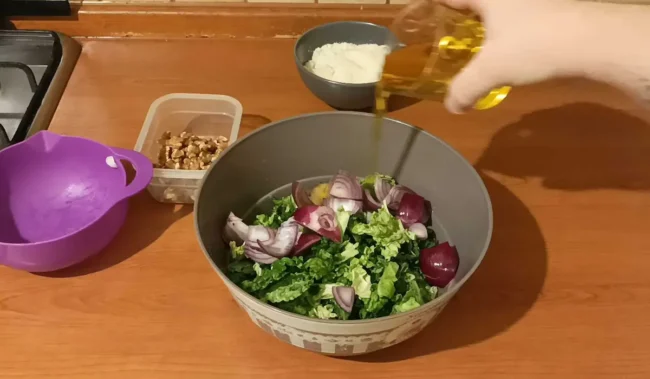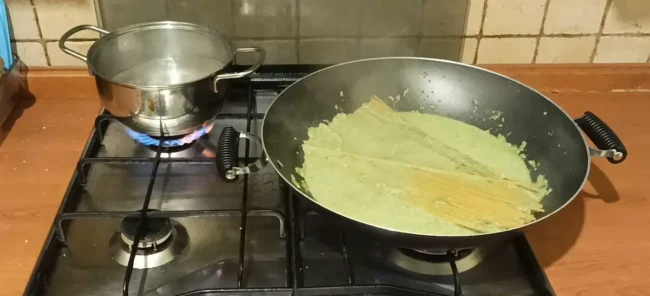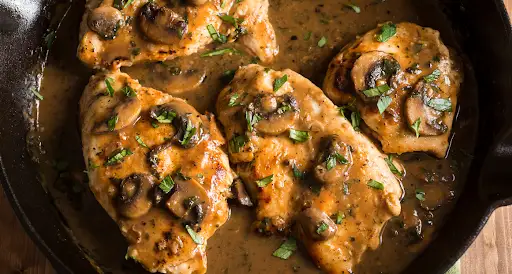I usually post quick and easy recipes that are ready in less than 20 minutes. This time, however, I want to share something that requires a little more effort and patience, but will reward you with its unique and delicate taste: bucatini with cabbage pesto sauce.
I came up with it on a night in which I particularly needed some comfort food. Which, for me, means a creamy, warm pasta dish that can fill your mouth with flavor and make you forget your day.
My mother had left at least 2 lbs of red cabbage leaves on the stove. I had been practicing with different types of pesto in those weeks, so I decided to make something similar with them. And I would cook the pasta directly in it. I do it in a lot of recipes because it allows using the pasta starch to make the sauce creamier.
I also happened to have a fair amount of butter and parmesan in the fridge, so I decided to do what we call mantecare, which is to add them to the finished dish and let everything sit for 5 minutes. It allows the dairy parts to bond with the starch in the pasta – again for the purpose of making everything creamier.
The result was delicious!
I’ve been making this dish often since that dinner. It’s one of my favorite options when I have to cook for the whole family. And if you want to try it at home, here’s what you need to do.
What you’ll need

Cabbage, obviously: it’s in the title. I’ve used a green one to make the pictures in this post, but if you are going to make this dish more than once, try using red cabbage sometimes. It will give your pasta a beautiful purple color.
Onions: I used two small red onions, but you can go with your preferred type.
Grated cheese: I’ve used a 50/50 mix of pecorino romano and parmesan cheese. However, you can just pick one of them. Parmesan cheese will give your pesto a nuttier flavor, while pecorino will make it saltier and spicier. If you’re curious about their differences, check my article on pecorino vs parmesan.
Extra-virgin olive oil: preferably a good quality one.
Butter: yes, this recipe has both oil and butter. But you won’t need much of it. Two knobs should be enough.
Walnuts: pesto can be made with different herbs and nuts (or be completely nut-free). I find that walnuts are the perfect fit for this one. Occasionally, I also like to add some almonds.
Bucatini pasta: or any pasta shape that you like. I like this sauce more with long types of pasta, though.
Fine & coarse salt: I tend to give it for granted, but pasta water should always be salted with a handful of coarse salt. You’ll also need some fine salt to season the cabbage pesto.
As per usual, you can find the precise amounts in the recipe card below.
Method
As I mentioned, this recipe takes a little longer than the other ones I usually share. So, let’s divide it into 3 parts.
Making the cabbage pesto sauce
Step 1: Clean the cabbage leaves one by one. Let them dry for a few minutes, then place them in a large bowl.
Step 2: fill a small pot with water, put it on the stove, and turn the heat on. This way, when you’ll need it to boil the pasta, the water will be already warm.
Step 3: Chop the onions and add them to the bowl.

Step 4: Add the olive oil as well, then blend everything.
I know, pesto tastes better when made with a marble mortar and pestle. I mean, its name comes directly from one of these two tools. However, this is mostly true for those made with basil leaves or herbs, which risk losing their fragrance due to the heat of the blender blades.
This risk is less with cabbage leaves. Also, remember that you will need a large amount of them for this recipe-much more than the amounts of basil required for a regular pesto alla Genovese. You probably wouldn’t be able to get them in most mortars on the market. So, I’d say there’s nothing wrong with using an immersion blender.
Step 5: Add the walnuts as well, and keep blending. Finally, do the same with the parmesan cheese. Salt to taste.

Cooking the pasta
Step 6: Transfer the cabbage pesto sauce to a wok or large skillet and cook over low heat for a couple of minutes.

Step 7: By this time, the water in the pot should have come to a boil. Add a handful of coarse salt and stir well.
Step 8: Add the pasta directly to the wok. Let it bathe in the pesto for a minute, then add 2 or 3 ladles of hot water. You don’t need much, just enough to cover all the pasta.
Step 9: Cook the pasta, stirring occasionally. After a few minutes, the water will begin to evaporate and the cabbage pesto will thicken. Add 1 or 2 ladlefuls of water again to continue cooking the pasta and avoid letting the pesto stick to the wok.

Note that the cooking process will be a little longer than usual. My bucatini took 8 minutes longer than the cooking time listed on the package to become “al dente.” So, taste the pasta every once in a while to check if it is ready.
You will also need to pay attention to how much water you add during the process. Ideally, when the pasta becomes al dente, all the remaining cooking water should evaporate within a minute. So avoid adding too much water all at once. Better to check the wok often and add it only when needed.

Final steps
Step 10: When the pasta is al dente and all the water has evaporated, move the wok away from the heat. Stir the pasta well, then add 2 knobs of butter and a dusting of Parmesan cheese on top of it, and cover everything with a lid. Let it sit for 5 minutes.

Step 11: When the waiting time is up, remove the lid, stir, and serve.

Bucatini with cabbage pesto FAQs
Q: How can I make the process faster?
A: I cooked the pasta in the sauce because I wanted to use all its starch to make the cabbage pesto creamier. However, this is already a rich sauce, so you could boil the pasta in another pot and then add it to the wok with 2 ladles of cooking water about 2 minutes before it’s ready. It should save you a few minutes.
Q: Can I do it without walnuts?
A: Yes, you can. Like for many other pestos, you can use pine nuts, almonds, pistachios, and other types of nuts. Or you can avoid them all if you’re allergic. It’ll be delicious anyway.
Q: Does this recipe work with other vegetables?
A: I’ve made something similar with broccoli and spinach.

Bucatini with Creamy Cabbage Pesto
5 Stars 4 Stars 3 Stars 2 Stars 1 Star
No reviews
- Author: Mortadella Head
- Total Time: 45 minutes
- Yield: 4 1x
Ingredients
14 oz cabbage leaves
1 big onion
1/4 cup pecorino cheese
1/4 cup parmesan cheese (+ 2 or 3 extra tbsp to use at the end)
7 fl oz extra-virgin olive oil
2 knobs butter
2 oz walnuts
14 oz bucatini pasta
fine & coarse salt to taste
Instructions
- Clean the cabbage leaves one by one. Let them dry for a few minutes, then place them in a large bowl.
- Fill a small pot with water, put it on the stove, and turn the heat on. This way, when you’ll need it to boil the pasta, the water will be already warm.
- Chop the onions and add them to the bowl.
- Add the olive oil, then blend everything together.
- Add the walnuts, and keep blending. Finally, do the same with the parmesan cheese. Salt to taste.
- Transfer the cabbage pesto to a wok or large skillet and cook over low heat for a couple of minutes.
- By this time, the water in the pot should have come to a boil. Add a handful of coarse salt and stir well.
- Add the pasta directly to the wok. Let it bathe in the pesto for a minute, then add 2 or 3 ladles of hot water. You don’t need much, just enough to cover all the pasta.
- Cook the pasta, stirring occasionally. After a few minutes, the water will begin to evaporate and the cabbage pesto will thicken. Add another 1 or 2 ladlefuls of water to keep cooking the pasta and to prevent the pesto from sticking to the wok. This process might take a few more minutes than the cooking time reported on the pasta box. Taste your bucatini every once in a while to check if they’re ready.
- When the pasta is al dente and all the water has evaporated, move the wok away from the heat. Stir the pasta well, then add 2 knobs of butter and a dusting of Parmesan cheese on top of it, and cover everything with a lid. Let it sit for 5 minutes.
- When the waiting time is up, remove the lid, stir, and enjoy.
Notes
Ideally, when the pasta is al dente, all the water should evaporate within a minute or so. If you add too much at a time, you might have to wait too much and overboil the pasta. So, make sure to add it 1 or 2 ladlesful at a time, and only when the amount you’ve added before has evaporated, or when the pesto sauce is about to stick to the wok.
- Prep Time: 15
- Cook Time: 30
- Category: Pasta









